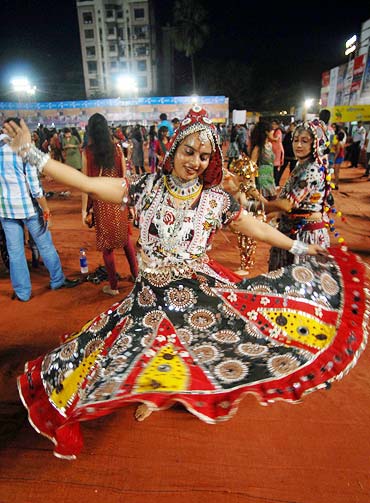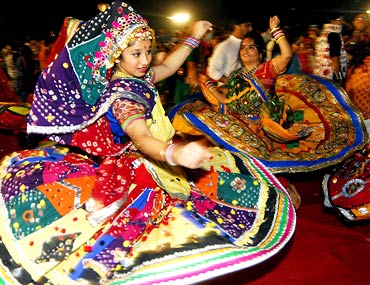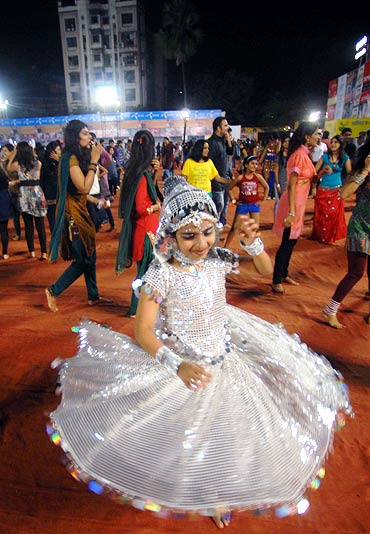
We bring you stories of Navratri revelry from across the country!
The glee has begun, the shopping is done, the whole city is decorated with lights and the air feels pristine! It's that time of year again, when Goddess Durga comes home to sanctify us with her love and shower us with her blessings. Beautiful pandals, overcrowded sweet shops, Gujarati songs etc form the essence of the festivities, which are followed for the next 10 days.
While it's the elders of the family who generally are a part of all rituals, it is the youth who imbibe traditional values and fuse them with contemporary fervor to make the most of this time. There are two main rituals associated with Navratri, which the younger generation eagerly awaits: there is Durga Puja on one hand, while there's dandiya on the other. Followed by Bengalis and Gujaratis respectively, in a city like Mumbai there is no difference as everyone comes together to celebrate both these traditions in an extremely splendid way.
We asked youngsters between the ages of 16 and 25 from various parts of India and Mumbai about how excited they are for Navratri, what their plans are and what they plan to do along with their friends. Each of them has their own way of celebrating and follow unique traditions. Read on!

Supratim Dam, 20, student, Guwahati
As Durga Puja is the main festival of Bengal and the North East, there is no need to explain how excited people are for the festival. The preparation begins almost a month in advance.
In our household, two things are compulsory; first, everyone has to buy new clothes and second, the kitchen is shut for five days -- we have to eat out. Though fasting is a tradition, my friends and I generally don't fast; it's a well-known fact that Bengalis love to eat!
We usually start our day at 2 in the afternoon, by visiting the nearest community and having a lunch of bhog distributed there. It is from there that we go to other pandals, eat and enjoy with friends. For almost four to five days there are no studies and no work, as everyone is completely devoted to the festival. At night, my family, friends and I go pandal-hopping and visit many all across the city and nearby areas, where we remain till the wee hours. Those nine days are not only extremely important for us traditionally, but also much-awaited socially.
Puja Choksi, 20, student, Surat
As dandiya is the main festival of Gujarat, people are officially crazy all through these nine days! We start our preparations a month prior, especially when it comes to clothes, as many of us get them stitched instead of buying readymade. Though garba classes start from July, we prepare the dance steps among our friends.
Famous grounds to play at are Indra Atadium and the St Xavier's School ground. Garba is played in almost every residential complex and also many open spaces and public grounds. The whole ground is divided into two sides, ie the traditional and Western and specific competitions are held for both. We hence start our preparations weeks in advance so that we ensure ours is the best dance and at least one member of our group bags the prize for the best costume! All this generally ends by 1:30-2 am and it is after this that we go for food and beverages.

Viditi Shah, advertising professional, 21, Mumbai
Though garba at my place is a very traditional affair, we as friends celebrate it in a more modern way. An earthen pot filled with moong dal with a diya placed on top is installed on the veranda of the house. This pot is called the garba and dances are performed around it. On the 10th day, the garba is immersed in a lake.
My friends and I generally play dandiya for one or two days, either in our residential complex or at some of the grounds of Goregaon, Andheri and Borivli. Dandiya is now basically restricted to going clubbing with your friends and dancing your night out to Gujarati music. Sadly, with the 10 pm restriction and office hours, we cannot play for more than an hour or two. So after visiting some pandals we generally go to these clubs like CCI, Radio Club and Red Light where they allow you in traditional kurtis for these nine days. Usually, after that we go to town and eat at Ayub's and Bade Miyan's and go back home pretty late at night.
Vinit Mehta, travel manager, 22, Ahmedabad
While there is no Durga Puja in Gujarat, dandiya raas and worshipping Goddess Amba is the biggest event here. Dandiya in Ahmedabad is the grandest affair, not only in Gujarat but across the whole country. All shops are shut by four in the evening and for many offices, all the nine days are holidays.
Going out to play dandiya is a compulsion for the young and old. I ensure that I have new clothes for all nine days and that should include one traditional dress without fail. We usually play at the Karnavati Club, where many Bollywood stars perform and also many well-known singers are called in. As there are no restrictions, we usually play dandiya all through the night and later go to various restaurants and sweet shops to try their special Navratri menus.

Priyanka Ghosh,20, student, New Delhi
Navratri for me is one time that I personally like to spend with my family, being part of all the traditions and rituals. We observe a fast till the morning aarti, in which the entire family takes part. After that, it's complete binging and going out to visit various pandals.
We make it a point to visit all the famous pandals of Delhi, especially the ones in Kashmiri Gate and Chittaranjan Park. In the afternoon, we make sure to try the bhog of various pandals, which is the Bengali equivalent of the Punjabi langar. At night there are various stalls serving delicious biryanis, rolls, sweets etc, which are definitely a visual and oral treat.
The most fun bit of the festival is the activities that take place at all the pandals. Apart from the food, there are many competitions and cultural events for everyone .The most amazing and culture-specific part of the festival is the Dhununchi dance performed by young men in front of the Durga idol. Durga Puja, like every other Indian festival allows everyone to be a part of it, Bengali or not. Moreover, even if you don't want to be a part of any of the activities, Durga Puja is an excellent time to spend time with relatives, meet friends, socialise and enjoy.
Parag Gopale, student, 19, Mumbai
As I have a lot of Gujarati friends, dandiya for me is more than just another festival. Not only do I get to dance and play, but meet all my friends with whom I am unable to catch up during the rest of the year, due to college and studies. We have dresses lined up for all nine days, which include both traditional and Western outfits. Though the traditional are usually hired, kurta-pajamas are usually bought every year.
The steps of garba and dandiya are generally impromptu, but my friends and I still meet a week prior and practice garba amongst ourselves. A group of five or six, we decide what theme and colour we wish to stick to and shop for clothes accordingly. This is done on a more personal level, as we all are really excited about the festival since it comes only once a year.
As all of us are extremely hungry after the dancing, all of us go and visit the mithaiwallas and eat our hearts out. Grounds that we generally visit are Sankalp in Goregaon, Raghuleela Mall in Kandivli, Kora Kendra in Borivli and Fun Republic, Andheri.

Vartika Shrivastava, 17, student, Gorakhpur
Gorakhpur, with its proximity to Bengal, is highly inhabited by many Bengalis. So Durga Puja for us is as grand as Holi or Diwali.
As the city is pretty small, there is a pandal almost at every 20 steps. Various competitions both for children and adults are held in all the pandals. Till a few years ago, we were participants there but are now a part of the organising committee. Competitions for drawing, singing, dancing etc are common for kids while for adults there are rounds of Housie, skits and group dances.
I generally visit all the pandals of the city with my parents, but spend almost the entire day at the pandal closest to my house. This year I am also part of the skit competition in the main pandal of the city, so preparations are in full swing.
Tunali Mukherjee, freelancer, 25, Mumbai
Though we are first generation-Bengalis from our family living in Mumbai, our parents always ensured that we didn't miss out on our traditions, despite being away from Kolkata. My Dad and me ensure that we take an off and wrap up all our pending work days in advance so that we get these four to five days totally to ourselves.
We make it a point to visit all the famous pandals of Mumbai, especially the ones at Grant Road, Chembur, Vashi, Dadar, Santacruz and Khar and have our lunch with the bhog distributed there. It is also compulsory that each and every member of the family have at least one new pair of clothes without fail.
Hardly anyone from our generation fasts, as the delicacies prepared during Durga Puja are best not missed. There are various types of biryanis, mutton dishes, sweets etc prepared for everyone to just binge on. Fasting is only observed on the eighth day ie Durgashtami, which is very auspicious for Bengalis.
Another aspect of Durga Puja is that we get to meet other Bengalis and hence all the pandals become a great center for socialising. Hence, Durga Puja for us is five days of complete feasting, socialising, spending time with family and merrymaking.